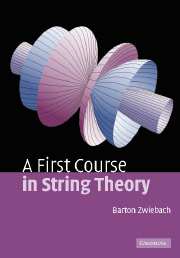Book contents
- Frontmatter
- Contents
- Foreword
- Preface
- Acknowledgements
- Part I Basics
- Part II Developments
- 14 D-branes and gauge fields
- 15 String charge, electric charge, and particle physics
- 16 String thermodynamics and black holes
- 17 T-duality of closed strings
- 18 T-duality of open strings
- 19 Electromagnetic fields on D-branes
- 20 Nonlinear and Born–Infeld electrodynamics
- 21 Covariant string quantization
- 22 String interactions and Riemann surfaces
- 23 Loop amplitudes in string theory
- References
- Index
18 - T-duality of open strings
from Part II - Developments
- Frontmatter
- Contents
- Foreword
- Preface
- Acknowledgements
- Part I Basics
- Part II Developments
- 14 D-branes and gauge fields
- 15 String charge, electric charge, and particle physics
- 16 String thermodynamics and black holes
- 17 T-duality of closed strings
- 18 T-duality of open strings
- 19 Electromagnetic fields on D-branes
- 20 Nonlinear and Born–Infeld electrodynamics
- 21 Covariant string quantization
- 22 String interactions and Riemann surfaces
- 23 Loop amplitudes in string theory
- References
- Index
Summary
T-duality relates a world in which a spatial coordinate on a Dp-brane is stretched around a circle to a different looking, but equivalent, world in which a D(p − 1)-brane has a fixed position on a circle of dual radius. In the first world open strings can have momentum along the circle but cannot wind around it, while in the second world they have no momentum along the dual circle but, as we will see, they can in fact wind around it. We use Maxwell gauge transformations to show that, on a circle, the values of the gauge field line integral ∮ Adx are periodically identified. The holonomy of the gauge field along a Dp-brane direction that is wrapped on a circle, is related by T-duality to the angular position of a D(p − 1)-brane on the dual circle.
T-duality and D-branes
Let us consider the propagation of open strings in a spacetime in which one spatial dimension has been curled up into a circle. Assume that we have a space-filling D25-brane, so that the open string endpoints are free to move all over space. As before, we choose the x25 dimension to be compactified:
All open string coordinates, including X25, satisfy Neumann boundary conditions at both endpoints, so they are all of NN type. In the presence of a compact dimension, closed strings exhibit fundamentally new states: closed strings can wrap around the compact dimension so that they cannot be shrunk to a point.
- Type
- Chapter
- Information
- A First Course in String Theory , pp. 410 - 424Publisher: Cambridge University PressPrint publication year: 2004



